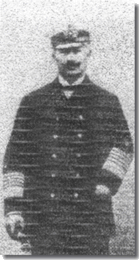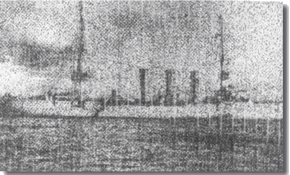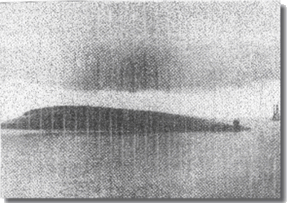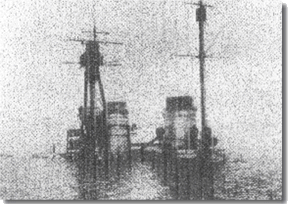|
Kaiser Wilhelm 11 in the uniform of a full Admiral of the High Seas Fleet
 | Introduction
Most of the German High Seas Fleet was to survive WW1 intact, under the Peace Plan, this fleet was sailed into internment at the British Home Fleet Base at Scapa Flow. (More about Scapa Flow and a map.)
400,000 tons of the Imperial German Navy, consisting of a total of 74 ships were anchored there.
On the 21st of June 1919, Rear Admiral Ludwig von Reuter, who was in command, gave the order to SCUTTLE them.
52 ships were sent to the bottom, this is a story unique in world Naval History.
Scapa Flow
I had first made my acquaintance with this British Home Fleet Base at Scapa Flow, as a Midshipman in HMAS Australia, far back on Friday the 20th. of July 1940.
My Midshipman's Journal entry for that day reads:
We cleared the Clyde, and proceeded at 23.5 knots, zig zagging, having streamed our paravanes as a precaution against any sown mines. A converted yacht was seen escorting a Thames Class submarine, and a Town Class Cruiser with two destroyers were passed. Paravanes were now recovered, as we passed through the outer, then the inner booms at Scapa. The ship came to the starboard anchor with seven shackles, in 17 fathoms.
There is a formidible force anchored here at Scapa Flow, the base for the British Home Fleet, and we are here to join it.
Three Battleships, two Battle Cruisers, six Cruisers, one Aircraft Carrier, and numerous Destroyers and smaller craft are anchored here in the Flow.
The weather here can swing like a pendulum, one day could dawn beautifully calm, the sea mirroring the clear blue sky above, the next day, violent winds, rain, and sullen grey leaden skies.
Mutiny in the German Fleet in November 1918
As WW1 was lurching to its end, there had been an ugly mutiny in the German Navy. The German Admirals had decided to make one final throw of the dice, an unexpected attack by their High Seas Fleet, upon the British Grand Fleet.
Rear Admiral Ludwig von Reuter's flagship Emden
 | On the 29th. of October 1918, 22 capital ships plus 12 light cruisers, and 72 destroyers sailed for an assembly point at Schillig Roads. This in fact was an even greater force than the German Navy had mustered at the Battle of Jutland.
But this bold plan just fell apart, the poor morale, and general discontent prevailing amongst the German sailors manning these ships took control. Part of the crews of two Battleships refused orders. The mutineers surrendered, were arrested, and taken off to Wilhelmshaven and prison. A general mutiny now broke out on shore in protest for this action taken against those who had been part of this mutiny at sea.
The High Seas Fleet was irrepairably damaged, its crews no longer prepared to fight for their country.
By the 9th. of November, the Kaiser, after abdicating, took off for the Netherlands, and the Armistice was signed two days later.
Armistice Provision
The provision that related to 74 ships to be handed over was covered by Article XX111 which stated:
The German surface warships, which shall be designated by the Allies and the United States of America, shall forthwith be dismantled and interned in neutral ports, or failing them, Allied ports, to be distinguished by the Allies and the United States of America, only care and maintenance parties being left on board. The vessels designated by the Allies are.........
The possibility of any German action to scuttle their ships was anticipated.
The possibilility that the Germans might decide and then try to scuttle these ships was anticipated by Article XX111, which included this paragraph:
No destruction of ships or of materials is to be permitted before evacuation, delivery, or restoration.
But the Germans had begun to think about scuttling, when they learned how the Armistice would affect their Navy, the decision to intern the ships at Scapa (rather than use a neutral port was generally withheld from the Navy, and the ships were quicky transferred to Scapa Flow). Germany had thought that a neutral port should have been used, as their Fleet was not defeated in battle, but they were inored before and after the internment.
Internment of High Seas Fleet
In accordance with the terms of the Armistice, the German High Seas Fleet had not surrendered but had sailed into internment at Scapa Flow in November 1918.
East of Hoy, these 74 ships were drawn up in sullen rows, 5 Battlecruisers, 11 Battleships, 8 Cruisers, plus 50 Destroyers.
They remained the property of Germany, but only had skeleton crews on board. There were no British Naval personnel in these German warships, they wore no ensigns, the German Naval Ensign carrying a black cross and an eagle was forbidden to be flown in British waters.
The Royal Navy force guarding this German fleet included 5 Battleships.
The plan to scuttle the High Seas Fleet
Rear Admiral Ludwig von Reuter had about 1,800 maintenance crew of Officers and Sailors aboard his 74 ships at Scapa.
He had decided to salvage some pride and honour for his Navy, by ordering crews to scuttle the German fleet upon a prearranged signal.
In the few days before the 21st of June 1919, there had been notable activity amongst all his ships, but only a few key Officers and senior Ratings knew what was going on and its ultimate outcome, and they were all sworn to keep the plan secret.
Within the German Fleet, it was expected that just as soon as the Armistice was over, and the Peace Treaty signed, the British would quickly move to seize all their ships, and no one, especially the German Admiral, were at all enamoured at this bleak prospect.
The 21st. of June 1919
This fateful day happened to fall on a Saturday, and at Stromness, a small port in the north west corner of Scapa Flow, some 400 local school children were patiently waiting to to board Flying Kestrel, an Admiralty tender.
Derfflinger, upside down resting on her upperworks, and looking like an island within Scapa Flow
 | They were aware of taking part in a very special treat, approved of by the Royal Navy, a trip around the interned German warships. The weather looked fine, as at 0930 (9.30 AM) the tender cast off, and proceeded to sea. They passed down the lines of anchored German ships, the children waved excitedly to the German sailors, it was a wonderful time for them all.
During the Flying Kestrel's meandering through the lines of the interned fleet, the British Battle Squadron, screened by its fussy destroyer escorts sailed out of the Flow into the open sea for Torpedo firing exercises.
Von Reuter could not believe his luck, all that was left to guard his ships were a couple of destroyers and some small patrol boats. Unwittingly, the Royal Navy had left the Scuttling door wide open for him, he could now execute his plan virtually unhindered.
At about 1000 (10 AM) the German Admiral appeared on Emden's quarterdeck in his full dress uniform.
At 1030 ( 10.30 AM ) a flag signal was hoisted in his flagship, in plain language it read: Paragraph 11. Bestatigen, translated Paragraph 11. Confirm.
After the scuttle, Hindenberg sits on the bottom
 | This was the Admiral's executive order to commence the Scuttling Operation.
Within 16 minutes the Battleship Friedrich der Grosse had rolled over and sank, the school children were to witness the destruction of a mighty Naval force, an event quite unique in world Naval History, suddenly taking place before their eyes, as 52 ships of the 74 present, were despatched to the bottom of Scapa Flow.
This unprecedented SCUTTLE was to produce both the last casualties, and the last Prisoners of War in World War 1.
In the eyes of Rear Admiral Ludwig von Reuter he had salvaged some pride for his beloved Navy, and denied his particular bete noir, the Royal Navy, and her Allies from gaining control of the German High Seas Fleet, for him, justice had been done.
|